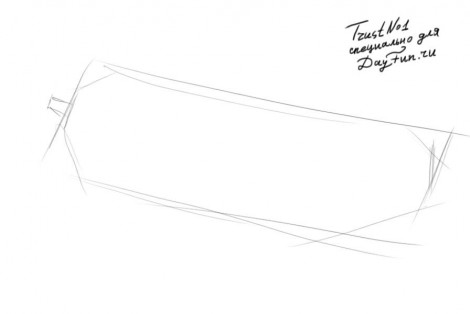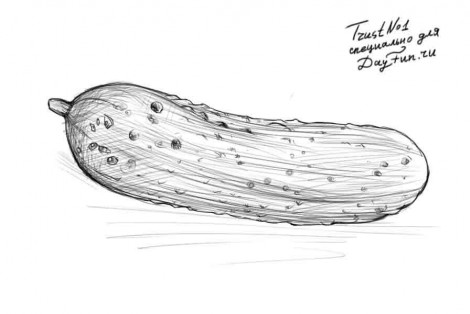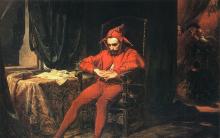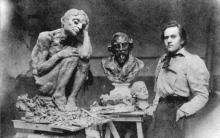The rapid development of mankind leads to the fact that people begin to be interested in very mysterious things, for example, why the sky is blue, why the light can not be kept in their hands and where they undertook. These questions are looking for the most intelligent minds, but with the discovery of the concept of DNA, it was found that everything around has DNA exactly the same way as a person that subtly hints at the possibility of origin from a person, or a person from everything. The closest relationship of a man on DNA was the cucumber. I was also shocked, so it should show you how to draw cucumber. Cucumber is a kind of cactus without sharp needles, the most cultural type of vegetable, respectively refers to a person and personifies everything solid, durable and necessary. For better perception painted in a gentle green color. A special property of cucumber is that it consists of a little more than a person, which means he is a little more humane. For the first time, he was discovered by the Chinese in the wildest non-cultural environment where there is still growing.
Like any other form of life, this on the planet, came out of the sea, where his ancestors are still found - sea cucumbers, very rare and shrinking algae. An ordinary cucumber quickly knows the essence of existence and being, from which it becomes yellow and getting fat, for it understands all the timelessness of his life.
Not all properties of the cucumber are open, but here are some considerations:
- Combining into one whole cucumber, milk and gastric juice can find the meaning of life. At least for several hours;
- It can be used as a weapon, proven by Chuck Norris;
- From it you can make a salad if you add mayonnaise;
- It is precisely because of the high value of cucumber as snacks invented alcoholic beverages;
Try to draw green on this instruction:
How to draw a cucumber with a pencil phased
Step one. To begin with, you need the form in which you draw a cucumber. Let it be rectangular and with a small rod on the left side.  Step second. Based on the previous stage, round out the contours.
Step second. Based on the previous stage, round out the contours.  Step Three. Add bursts and circle the contours more clear.
Step Three. Add bursts and circle the contours more clear.  Step fourth. With the help of horizontal hatching, sketch cucumber.
Step fourth. With the help of horizontal hatching, sketch cucumber.  Did you get? Hope so. And I recommend to try other fruits of nature, less or more delicious.
Did you get? Hope so. And I recommend to try other fruits of nature, less or more delicious.
Paisley is a noble ornament, "Tears of Allah", Turkish Bob, or Japanese Cucumber Turkish Cucumber, Japanese Cucumber, Paisley, Indian Cucumber, Persian Cypress, East Cucumber, Bout ... Everyone calls him in his own way. In the East - Bout, in Europe - Paisley. All this names of one pleasant oriental ornament, which became a classic.
The birthplace of the ornament is Persia (according to some sources - India).
This ornamental motive was characteristic of Persia and Iran from the time of the Sassanid dynasty (III-VII century) and developed to the diversity of forms already by the XVI-XVIII centuries - the time of the board of the Sefavid dynasty.
Robert Lefevr. Portrait of Elizabeth Demidova. 1805.
Such an ornament was decorated with clothes, jewelry, dishes, household items and religious cults, in the form of "cucumber" even baked cakes.
There are no unambiguous interpretations of the origin of the "Cucumber" form. Some sources say it is a floral ornament depicting a barr, a bump, flower and symbolizing fertility, wealth. In modern Iran, a gift with this image is considered the wish of the well-being of the house.
Other - this is one of the symbols of Zoroastrianism, depicting the languages \u200b\u200bof flame and symbolizing courage, courage. The word "butt" (the name of the ornament) on Sanskrit means "fire".
In India and Pakistan, the drawing is associated with the shape of a mango seed - curry on Pakistani and Ambi on Hindi.
In the Russian tradition, the name "Cucumber" was adopted from the English language. In America in professional slang manufacturers, the name "Pear" sometimes meets the name.
Antoine Jean Gro. Empress Josephine, 1808
The pattern became popular in Russia and in Western Europe in a new time (XVIII-XIX century) due to imported from the East Cashmere tissues with a "cucumber" pattern.
In the UK, the Indian Cucumber got spread after the British Army returned from the colonies brought home oriental fabrics (the first half of the XVII century). The main center of the production of cheap tissues with such an ornament in Western Europe was the Scottish city of Paisley (in honor of which the ornament and received his name in the West). Paisley was not the only place where they made fabrics with this pattern. So "cucumber" from the east of Europe. The production of fabrics from Paisley lasted in Scotland about 50 years, and then gradually sued no.
1840s.
1850s.
Dress 1860s.
Alfred Stevens.After Bala.1874.
Semi-Falte-Doloman of the 1880s.
Start of the 20th century.
Another explosion of popularity came for Hippie - 1960s.
The ornamentary ornament served psychedelic and flower preferences of subculture. At the same time, in a male fashion, a Furior Galstuk-Paisley was produced, which to this day is considered a classic sample of ties.
Paisley's drawing has become a business card of many famous fashion houses, including Etro, Pucci, Missoni and many others.
1950s.
1970s.
This pattern remains relevant today and from time to time again appears in the collections of famous fashion designers.
Jil Sander Spring-Summer 2012
According to designers and art historians, this unusual and very ancient pattern today is going through the next round of popularity, on its basis, many famous brand clothing brands have managed to release completely different and very original forms of clothing.
But why exactly "Turkish cucumber"? What kind of strange name is and where does it originate from? Why is it so popular and why is known literally around the world? Let's deal with.
History of amazing ornament
"Turkish cucumber", "Persian cypress", "Japanese cucumber", "East cucumber", Bout, "Tears of Allah" and, perhaps, another of its most common names - Paisley ... And this is not all the "names" of this unique The pattern, which is not just known to almost the entire white light, but also in almost every country has its own, special, history of origin.
This drawing is really able to boast ancient, and so to the end and unknown, the history of his origin, which, according to experts, began in the ancient empire of Sassanids, approximately in 225 to our era. In fact, it is the territory of modern Iran and Iraq, and therefore these countries can be considered by the Turkish cucumber.
Thanks to trade relations, over time, fabrics from Paisley got to the countries of Central Asia, spread in Africa and India, from where, in principle, and got into Europe at the beginning of the XVII century thanks to British migrants.
A beautiful oriental ornament is usually covered with shawls and shawls, which were highly valued in those days, only aristocratic and rich personnel could afford them.
The unusual pattern was so liked by Europeans that in the Scottish town called Paisley even launched mass production of fabrics with a "cucumber" pattern, from where, by the way, he received his next name. True, the first time the products were very inferior to Indian, did not please the scarce palette of colors, and the quality was much worse.

But, over time, the factory developed more and more, "Cucumber" from the East became more and more popular and spread to the masses, which deprived him of the initial value and uniqueness of authentic motives. By the end of the 19th century, Paisley lost the relevance at all, fell during the period of long oblivion.
They remembered its existence only after a century, and this happened because of the famous group The Beatles, suddenly "Turkish cucumbers" become a symbol of hippie movement. After that, the unusual drawing is forgotten again, and the next rebirth of the famous "Eastern Cucumber" falls in the mid-2000s and continues until now.
Value
But why is it still "Turkish", and also "cucumber"? Basically, this is the Russian name, because the motives of such patterns are often found on the tissues of Russian ladies, starting from the 18th century. A vivid example is Pavlovsky handkerchiefs and shawls, Ivanovo sitherium with its printed ornament, dresses and covers for furniture and so on.
And the name was simple: "Cucumber", since the form of the pattern is very similar to this vegetable, well, and "Turkish", because the drawing came to us from the east, and Turkey has come to Rus at that time, Turkey has been associated with him.

As we have already spoken, in each country this drawing got its name and mysterious interpretation. For example, in India, the drop-shaped pattern of the pattern personifies with the symbol of God Ganesh, Mango, or with a palm sheet. According to Indians, this is a symbol of life, movement forward, energy and the forces of nature, probably not in vain with the help of the "cucumbers" decorate the traditional outfit of the Indian Bride.

For all Arab countries, the pattern has one name - "Tears of Allah", but the name "Persian cypress" symbolizes a sheet of cypress tree, which, in turn, speaks of eternity and life. In Turkey, "Eastern cucumbers" refer to "beans", and in Azerbaijan - Bout. In fact, "Butt" means "flame" or "fire", which in the ancient religion of the world, zoroastrism, again, symbolizes life.
Paisley today
Nowadays, cucumber's motifs from the east are widely used not only in clothes, scarves and shalms, but also in the interior design, with its help decorate bedding and covers for furniture, usually by embroidery or color printing.

Very interesting, Turkish cucumbers look at the elements of the decor, crocheted or knitting, embroidered with threads or beads, painted or even wrought. Elements of such an ornament can be found on the dishes, various accessories, wallpaper, tiles, women's bags and even in the subjects of jewelry!
Modern girls with great pleasure wear decorations in the form of a necklace, earrings or suspensions, which repeat the famous form of "Turkish Bob". In addition, cucumber motives are found even in landscape design, manicure art, cooking and any other industries of human life.

Today, the manifestations of the cucumber pattern are the most amazing and diverse: elements can be large and small, sophisticated and, on the contrary, deliberately coarse, blurred and clear, decorated with many additional curls and patterns, monotonous or made in a saturated color scheme.
The phased drawing of vegetables with children is useful in that on these simple objects you can teach children to analyze the form of the subject and decide how to transfer it on paper. Very many vegetables are close to the shape of a ball. Carrying them to the plane, you will draw a circle. But this circle ball is not always obvious to children. For example, in Luke it must be found. And also find out what needs to be added to get exactly a bun. As with any gradual drawing with children, try to avoid when drawing vegetables thoughtless copying.
All the vegetables on the pictures are painted with paints. But pencils are suitable for working with children. Vegetables - Wonderful Objects to process work skills with pencils! Tell the children that you need to paint the ball, considering and as if repeating its shape (that is, rounded lines). The pencil should not put too much. Hand movements should be light. And, of course, do not follow the contour of the picture. But, after all, for preschoolers it is better to work with gouashe colors!
Tomato - gradual drawing with children of vegetables
Draw a tomato very simple! Its almost spherical shape and homogeneous color is easily transmitted on paper. So that we have turned out, not a red circle, but a tomato, add white glare and green leaves. Please note that the leaves are like an asterisk. 
Phased drawing scheme with tomato children.
Radish and repka - Phased Drawing with Children's Children
Radish is also simple in the form of a vegetable. Difficulty can only represent its painting - pink radish, gradually turning into a white tail. If de paint a purple, purple color the whole root, then get beet. A similar way can be painted and represented. But she, rather, is not a ball, but an ellipsoid. So on paper, it is necessary to depict it oval. And paint, respectively, yellow.
 Phased drawing diagram with radishes.
Phased drawing diagram with radishes.

Phased drawing scheme with repka children.
Onions - Phased Drawing with Children's Children
Another "round" vegetable. But here it is not so obvious as a tomato. In the drawing onions with green "arrows". From the point of view of the culinary qualities of the onion bows is not great. But it is very elegant.

Scheme of phased drawing with Luke children.
Cabbage - Phased Drawing with Children's Children
Although doubt that Kochan Cabbage is a ball in children does not arise, it is a rather complicated object for drawing. It's all about the leaves-leaves. As in the riddle one hundred clothes - and everything is without fasteners. Therefore, we propose to make a picture of cabbage less realistic, more decorative.

Phased drawing scheme with cabbage children.
Cucumber - gradual drawing with children of vegetables
Cucumber is not at all the ball. This is a very elongated ellipsoid. On a flat pattern, the cucumber will turn into an oval. In the form of cucumber - one of the most simple vegetables. But to paint it as not a green oval, namely, the cucumber is quite difficult. The dots or curls will help here - these are "pummers" on the cucumber.
 Phased drawing diagram with cucumber children.
Phased drawing diagram with cucumber children.
Carrot - Phased Drawing with Children's Children
Carrot is a cone. On the plane, it will turn into a triangle from which we are then rounded a short side.

Phased drawing scheme with carrot children.
Study with children of vegetable form you can continue. For example, . And you can first make it, and then try to transfer volumetric forms to flat paper.
It seems that the famous "Indian cucumber" as a pattern is now experiencing a new round of popularity - on its basis, very many famous brands managed to release completely different forms of clothing. To wear such things with knowledge of the case, Furfur decided to remember the main points in the history of this picture.
History of origin pattern
Paisley, Indian cucumber, or, if quite accurately, boot - the pattern is very ancient. Probably, for the first time he appeared in the empire of Sassanidov - ancient state, from 224 to 651 years of our era who were located on the territory of modern Iraq and Iran. Thanks to trading ties of tissue with this pattern, spread throughout Central Asia and came even to India and Africa. In Europe, "cucumbers" fell from India in the XVII century thanks to British colonists. The demand for exotic Indian fabric turned out to be so high that enterprising Europeans began to weave the canvas with the "cucumbers" themselves. The small Scottish town of Paisley generally completely directed all the resources on the production of fabric in Indian style and thanks to this remained in the centuries - but already as the name of the pattern itself.
In the fact that Paisley actually represents, there is no one. One of the versions is a floral motive combined with a silhouette of a cypress - a symbol of life in zoroastrism. Another option of origin is stylized flame languages, also symbolizing life. The origin of the walnut of the cashew, which was a symbol of fertility. In India, it is believed that the "cucumbers" depict the seeds of a mango tree. In any case, what kind of theory does not take - we are talking about life and fertility. Some manage to consider even spermatozoa in Paisley - but, given the antiquity of the pattern, this version is extremely dubious.
The appearance of Paisley in Europe and the USA
The first popular goods with Paisley's drawing in Europe were cashmere shawls. They were extremely expensive, and only secured aristocrats could afford them. At the beginning of the XIX century, Scottish masters learned to weave "cucumbers" on jacquard weaving machines - and shawls became a more massive product with paisley. True, they were no longer cashmere, but from sheep wool or silk, and the colors were significantly less than that of the authentic Indian goods.

Even a little later, Paisley begin to print on cotton, and the pattern ceases to be a luxury, and by 1870, the "cucumbers" are not entirely out of fashion, but rather move to the ordinary area.
|
In the 1970s, Paisley suddenly became the attribute of hippie movement - mainly thanks to Beatles, which were brought from their famous journey Indian flavor |
Such a situation will continue until the seventies of the 20th century, when Paisley suddenly becomes an integral attribute of hippie movement. It happened mostly thanks to The Beatles, who brought the Indian flavor from his journey to Rishikesh to the Maharishi Guru.

Suddenly, the "cucumbers" appear everywhere: on Rolls-Royce John Lennon, on shirts with a huge collar, on pasted trousers, on the linings of the jackets and on the jackets themselves, women's dresses and baby strollers.
|
The time of the psychedelic revolution passes, but the "cucumbers" remain a symbol of the Bunlet spirit. Gradually, Paisley adopt into their visual dictionary Street groups - multicolored bandans with "cucumbers" become a way to distinguish their own from others. In the LGBT community, at the same time, color bandans, tied on the right or left to the belt, help gays not only to determine their likes in the crowd, but also immediately declare sexual preferences. "Cucumbers" and bandans become so interrelated concepts that the paisley pattern is often called Bandana Print. The 1980s, the 1990s and the beginning of the 2000s are carried out in a light oblivion, periodically popling into the clothes of some rock musicians. An exception is made up from 1984 to this day, the Italian brand ETRO, as well as classic English ties and scarves and scarves. Ancient Madder ties from printed silk are often decorated with a print from "cucumbers" and are a classic element of the XX century. |
"Cucumbers" and bandans become so interrelated concepts that the paisley pattern is often called Bandana Print. |
Paisley pattern today

Now Paisley is experiencing a new flourishing. Back in the middle of the two-thousand-old Street-brand The Hundreds released a black jacket with a hood and white "cucumbers", which is now considered collectible. But the coolest guys painted each "cucumber" manually.
This year, with Paisley's drawing, Vans released sneakers, undefeated - cap, Opening Ceremony together with Adidas - a whole collection of clothes and shoes, Herschel - backpacks, and Fred Perry, together with a well-known manufacturer of Drake's Tie - a series of polo and shirts. Given the appearance of Paisley on the tracks during fashionable shows this year, it can be assumed that in the summer we will find a new wave of hobby "cucumbers". In the end, not all wearing camouflage.











Poems of Agnia Barto for children
Nikolay Nosov: An entertaining biography of a children's writer in stories and pictures
Our favorite children's writers stories of famous writers for children
Luvital secrets - can you really fly by air?
Secret of Levishing Street Yogis